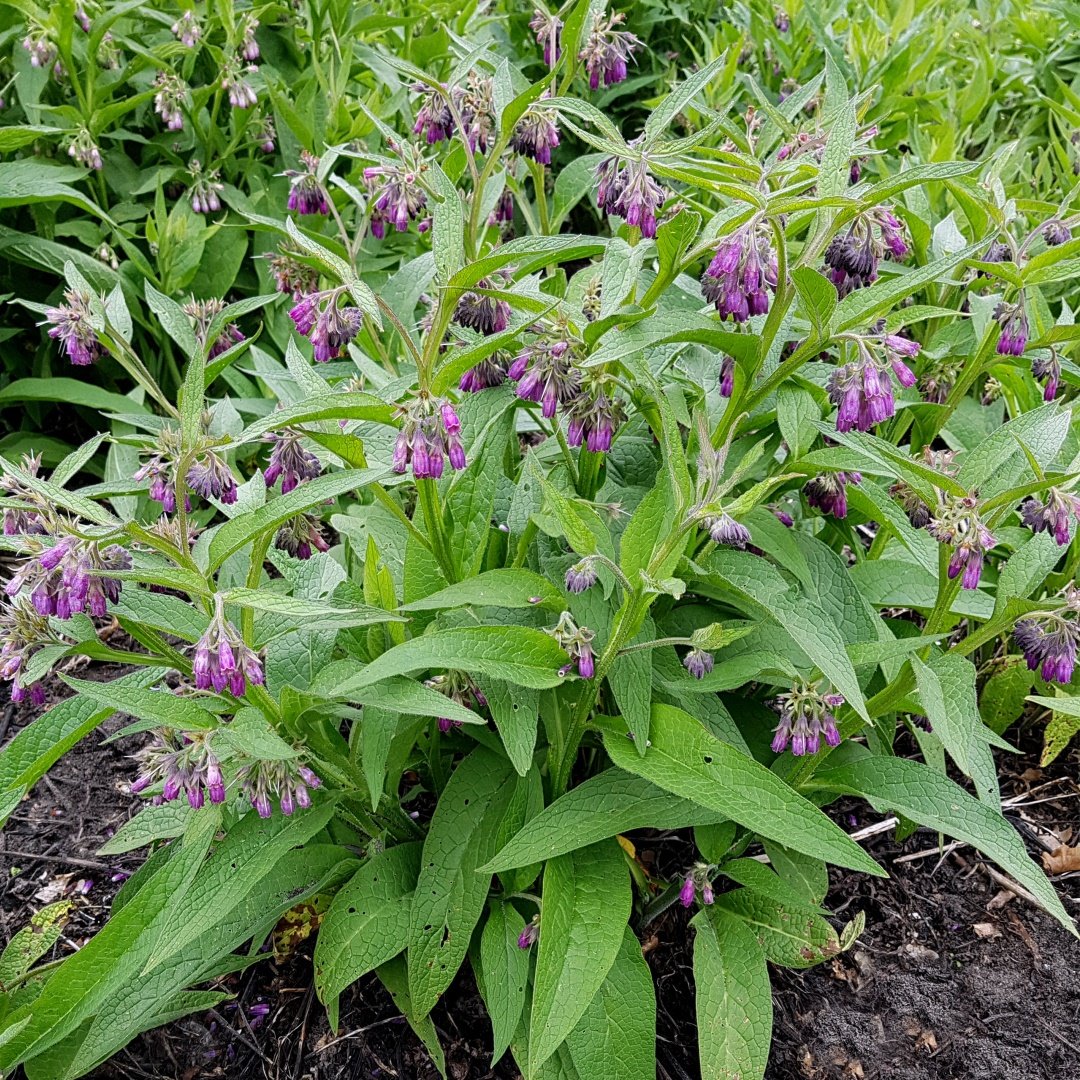
Comfrey
Identification, Habitat & Growing
Common Names:
Common comfrey, knitbone, knitback, boneset, consound, slippery-root, quaker comfrey, cultivated comfrey, blackwort, bruisewort, gum plant, consolida, ass ear.
Latin Binomial:Symphytum Officinale L.
Plant Family:Boraginaceae (borage family)
Duration:Perenniel
Habit:Herb, large, coarse, tuberous, clumping, capable of growing to to 1 meter tall and 1 meter across.
Leaves:Large basal leaves, pointed, hairy, ovate lanceolate, dark green in colour and grow to about 20-30cms long. Upper leaves are decurrent, smaller. Mature leaves are winged.
Stems:Stems are green in colour, hair, erect to ascending, clump forming, branched.
Flowers:Tubular, bell shaped, 1-2cm long, white, pink or purple in colour, 5 shallow lobes, borne in drooping clusters. Clayx and stalks are covered in bristly hairs.
Fruit & Seeds:Clusters of 4 nutlets maturing to shiny brownish-black in colour.
Habitat & Growing Regions:Native to Europe and Asia. Can be found in roadsides, on the banks of rivers, ditches, fields, yards and disturbed sites. Often found “escaped”.
Comfrey will grow in almost any soil type or situation but does best growing under the shade of trees.
I have several large clumps of comfrey that started from tiny divided plants purchased from a local market. One such plant died right off last year from a lack of water but I have just noticed recently that there is a comfrey plant shooting up in that spot and taking off.
It is a very hardy plant and can be dug up and divided with rigour and create a good many new plants from a single clump.
Reproduction & Propagation:By seed and vegetatively by root fragments or division. The roots will break up easily and the tiniest bit of root will
Harvesting & Storage:Foliage best cut before flowering. Comfrey leaves have a higher moisture content than a lot of plants and therefore take longer to dry than some. Make sure the leaves are crumbly before storing or any dampness will cause mould.
Harvest the roots in Autumn. To preserve the roots for later use they can be sliced and dried or macerated as an oil-infusion.
Similar Species:Tall bluebells (Mertensia paniculata)
Companion Plants:Fruit trees, perfect for planting around the bottoms of fruit trees for moisture retention. Comfrey is also a nitrogen fixer and makes a fabulous chop and drop mulch for around the bottoms of fruit trees.
Garden Care & Uses:Add harvested leaves to a bucket of water and leave to steep for 2 weeks and you’ll have comfrey compost tea which is fabulous for the garden as a fertilizer.
Very difficult to remove by hand as any root fragment left behind can easily regrow.
Toxicity to pets and other animals:As with human use, some sources have stated it may cause liver damage in cats and dogs when ingested in large quantities.
In Herbalism
Parts Used:
Leaves and roots.
Constituents:Tannin, rosmarinic acid, allantoin (0.6 to 0.8%), steroidal saponins, mucilage, inulin, pyrrolizidine alkaloids, gum, carotene, glycosides, sugars, beta-sitosterol, triterpenoids, vitamin b-12, protein, zinc.
The chief and most important constituent of comfrey root is mucilage, which it contains in great abundance, more even than marshmallow. Starch in present in a very small amount.
Preparations:Salve, poultice, infusion, decoction, can be added to soups and salads.
Dosing:Sprains, swelling and bruising – A formentation.
Severe cuts and to promote the suppuration of boils and abscesses, gangrenous and ill-conditioned ulcers – The whole plant beaten to a cataplasm and applied as a hot poultice
For diarrhoea and dysentry – Decoction is made by boiling 15-30g of crushed comfrey root in 0.5 – 1L of water or milk which is taken in winglassful doses, frequently.
For demulcent action in lung issues, quinsy and whooping-cough, the root is more potent than the leaves and is the part most often used in case of coughs.
A strong decoction, or tea, is recommended in cases of internal haemorrhage, whether from the lungs, stomach, bowels or from bleeding piles – to be taken every two hours till the haemorrhage ceases, in severe cases, a teaspoonful of witch hazel extract being added to the Comfrey root tea.
A modern medicinal tincture, employed by homoeopaths, is made from the root with spirits of wine, 10 drops in a tablespoonful of water being administered several times a day.
Any ingestion shouldn’t go past a week long period.
Energetics:Cool, moist
Taste:Bland, slightly sweet
Actions:Tonic, demulcent, expectorant, vulnerary, mildly astringent, anti-inflammatory
Key Uses:Frequently given when mucilaginous medicine is required and has been used like marshmallow for intestinal troubles. Very similar in its emollient action to marshmallow but in many cases comfrey is even preferred.
It forms a gentle remedy in cases of diarrhoea and dysentry.
Contraindications:There is a lot of controversy out there about taking comfrey internally , especially root preparations. This came about from a study where in a laboratory they took the pyrrolizidine alkaloids from comfrey, concentrated it and injected it into the livers of mice. The mice died of liver failure. So if you have liver problems, it might be best for you to avoid ingesting comfrey.

